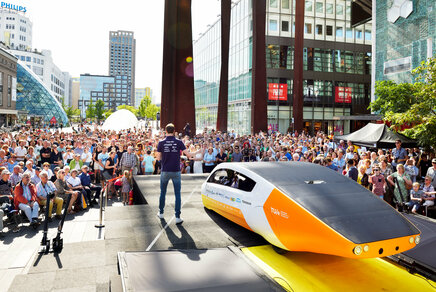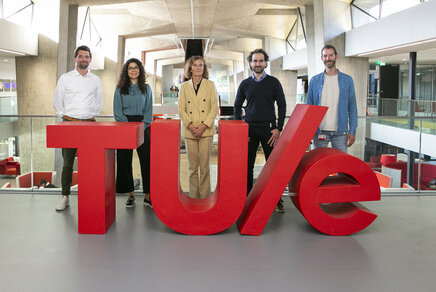TU/e students will race autonomously for the first time on Formula 1 circuit Barcelona
Electric racing car of team University Racing Eindhoven can reach 50 kilometres per hour in corners and up to 115 kilometres per hour on straights without a driver.
After years of preparation, student team University Racing Eindhoven (URE) from TU/e will compete in Barcelona (from August 2 to 8) for the first time in the newest class of the Formula Student competition: the autonomous class. The aim is for the racing car to tear across the track without any human help, with the vehicle - which is electrically powered - and the autonomous system being designed entirely by students at TU Eindhoven.

FOURTEEN OTHER TEAMS
Dennis Gubbels, URE team manager, is looking forward to the race: "Of course we are going for first place. It would be great if our autonomous racing car won during its first race, just like Max Verstappen won his first Formula 1 race on the same circuit in his new car. We want to win and I definitely think we can."
Since no driver is involved, the team only has a device to signal the start of the race. In Spain, URE will compete in the autonomous class, which reaches speeds of 115 kilometres per hour on straights, against 14 other teams from the US, Portugal, Germany, Italy and Norway.
During the competition in Barcelona, teams take turns on the track. They are judged on various racing disciplines, such as cornering speed, acceleration, endurance and a qualifying lap. The team wanted to participate in an autonomous race two years ago, but did not fully pass the technical inspection, which meant that the race disciplines could not be performed.
STUDENTS FROM VARIOUS FACULTIES
The racing car has been completely designed and developed by students from different faculties. That is why not only the performance of the car itself is important, i.e. the race disciplines, but also the entire design process will be judged by jury members from the automotive industry. Furthermore, the participating teams have to make a detailed overview of all their costs, parts and labour processes. Finally, all teams must draw up a profitable business model around their developed racing car.

right connection
Gubbels explains that the team has to pioneer, because autonomous racing is still in its infancy. There are hardly any competitions. "That is why this is a big challenge for us. For example, the systems often work fine individually, but finding the right connection between the hardware and software is a difficult job. The sensors and cameras are the eyes of the car, the software package is the brain of the car and the steering unit and motors are the limbs. Everything has to be perfectly tuned to each other. If there is even a fraction of a second delay, it can cost a lot of time. We have worked hard on the car over the past year and hope to show the results in Barcelona."
Besides the autonomous competition in Spain, the team has participated in the long-standing electric class several times, such as at the beginning of this month at the TT circuit in Assen. Of the thirty participating teams, URE came in second. The electric racing monster that started in Assen is now being converted into an autonomous car by replacing the front and rear wing with a computer and a set of extra sensors. Gubbels: "We can transform our electric car into an autonomous vehicle and vice versa in a short period of time. That car concept is unique."
Latest news



